Real Threats From False Information in Ukraine
Recent disinformation campaigns and physical threats target the OSCE’s Mission to Ukraine
Real Threats From False Information in Ukraine
Share this story

BANNER: Source: Wikimedia commons
The Organization for Security and Co-operation in Europe (OSCE) Special Monitoring Mission (SMM) to Ukraine continues to face increased security risks as a result of targeted disinformation campaigns. Harassment and security impediments inhibit the mission’s ability to provide crucial verified reports on the conflict in eastern Ukraine. As @DFRLab previously reported, anti-OSCE violence and disinformation have been seen since the launch of the mission. Security assurances for the SMM are required by multiple international agreements, but between mines and unexploded ordinances (UXO), physical aggression, and harassment, the SMM is unable to function at its full capacity.
On June 20, an SMM patrol was attacked and fired at near the railway station in non-government-controlled Yasynuvata, Donetsk Oblast. Two armed men from the so-called “Donetsk People’s Republic” (“DNR”) attempted to break into an SMM vehicle while pointing an assault rifle at the unarmed civilian monitors inside. The armed men fired at the patrol as it fled. Relevant parties and the international community condemned the attack, but incidents like this are part of a continuing pattern. In this instance, OSCE SMM Principal Deputy Chief Monitor Alexander Hug held the “DNR” responsible and said, “The ‘DNR’ is unable to control this area or unwilling to control its own men.”
.@statedeptspox Nauert comments on violence and intimidation in eastern #Ukraine pic.twitter.com/Kq0qWzV8db
— Department of State (@StateDept) June 22, 2017
During the question and answer portion of the same briefing, Russell “Texas” Bentley, a foreign fighter for the “DNR” and a self-proclaimed media and “information warfare” producer, asked follow-up questions about the June 20 incident. In the live video, Bentley cast doubt on the incident and asked for evidence to prove the “accusation.” Bentley’s line of questioning, as shown during the briefing and on his website, embodied the Russian-led separatist disinformation campaign targeting the OSCE.
[facebook url=”https://www.facebook.com/oscesmm/videos/839247602893613/” /]
A few days later, on June 23, another SMM patrol was caught in crossfire near government-controlled Zolote-4, near the Zolote disengagement area (DA) in Luhansk Oblast. The patrol narrowly escaped unscathed, recording high-intensity small arms fire, 82mm mortar fire, and automatic grenade launcher (AGS) fire.
A third incident occurred on June 29 when two armed men with assault rifles from the so-called “Luhansk People’s Republic” (“LNR”) threatened to shoot SMM members in Vesela Hora, Luhansk Oblast. The armed men alleged that SMM members congratulated residents of Vesela Hora on Ukraine’s Constitution Day — celebrated on June 28 — and stated they would shoot SMM members if the message was repeated. After the SMM issued the daily report recording this incident, the “LNR Information Center” published an article, which accused SMM monitors of aggressively congratulating people on Constitution Day.

The “LNR Information Center” requested that OSCE leadership conduct an official investigation into the incident; a spokesperson from the “Ministry of Defense of the LNR” cited concerns about the principles of the SMM. Casting doubt on the SMM’s ability to execute its mandate endangers the unarmed civilian monitoring mission.
The OSCE SMM’s verified reporting is an essential source of information on the conflict in Ukraine. Both the Russian-backed separatists and Ukraine provide one-sided reports on the conflict, though we see far more instances of outright lies from separatist news sources, such as far-fetched stories of an “Islamic battalion” assisting the Ukrainian government in Mariupol. However, it is important to monitor the output of both sides, especially as it relates to the reporting of the neutral OSCE SMM to Ukraine. On June 30, the Ukrainian Anti-Terrorist Operation (ATO) Press Center falsely reported that militants from the “LNR” shelled the OSCE SMM’s newly opened forward patrol base in Popasna, Luhansk Oblast, the night of June 29 with weapons banned by the Minsk Agreements. The OSCE SMM promptly clarified the statement, issuing a “fact check” noting considerable shelling in the area the night of June 29, but not directly on the base. All of the mission’s staff were safe and no damage had been sustained.
Lack of accountability and action to address harassment and security restrictions despite international agreements led to the death of one SMM monitor, an incident that still substantially affects the SMM’s reporting abilities. Without necessary security assurances, the SMM is unable to facilitate repairs to critical infrastructure, provide humanitarian aid, establish ceasefires, or be the sole provider of crucial verified facts from the conflict in eastern Ukraine.

